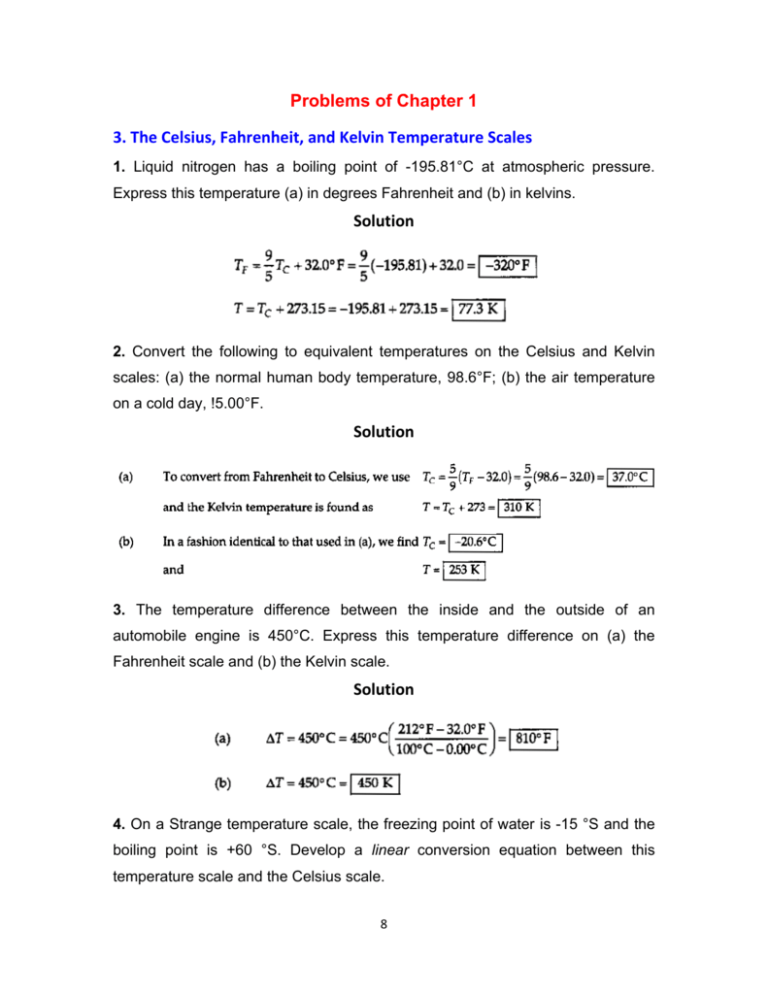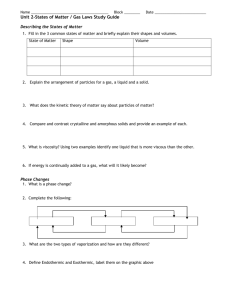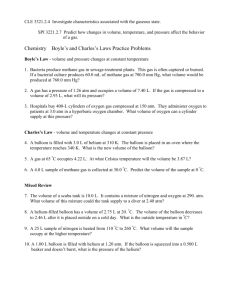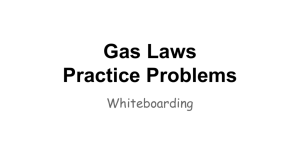3. The Celsius, Fahrenheit, and Kelvin Temperature Scales
advertisement

Problems of Chapter 1 3. The Celsius, Fahrenheit, and Kelvin Temperature Scales 1. Liquid nitrogen has a boiling point of -195.81°C at atmospheric pressure. Express this temperature (a) in degrees Fahrenheit and (b) in kelvins. Solution 2. Convert the following to equivalent temperatures on the Celsius and Kelvin scales: (a) the normal human body temperature, 98.6°F; (b) the air temperature on a cold day, !5.00°F. Solution 3. The temperature difference between the inside and the outside of an automobile engine is 450°C. Express this temperature difference on (a) the Fahrenheit scale and (b) the Kelvin scale. Solution 4. On a Strange temperature scale, the freezing point of water is -15 °S and the boiling point is +60 °S. Develop a linear conversion equation between this temperature scale and the Celsius scale. 8 Solution T o C 0 T o S (15) 100 75 T o C 0 T o S 15 100 75 To C 100 o (T S 15) 75 T o C 1.333To S 20 5. The melting point of gold is 1064°C, and the boiling point is 2660°C. (a) Express these temperatures in kelvins. (b) Compute the difference between these temperatures in Celsius degrees and kelvins. Solution 4. Macroscopic Description of an Ideal Gas 6. Gas is contained in an 8 L vessel at a temperature of 20 °C and a pressure of 9 atm. (a) Determine the number of moles of gas in the vessel. (b) How many molecules are there in the vessel? Solution 7. An automobile tire is inflated with air originally at 10°C and normal atmospheric pressure. During the process, the air is compressed to 28 % of its original volume 9 and the temperature is increased to 40 °C. (a) What is the tire pressure? (b) After the car is driven at high speed, the tire air temperature rises to 85 °C and the interior volume of the tire increases by 2 %. What is the new tire pressure (absolute) in pascals? Solution 8. A tank having a volume of 0.1 m3 contains helium gas at 150 atm. How many balloons can the tank blow up if each filled balloon is a sphere 0.3 m in diameter at an absolute pressure of 1.20 atm? Solution 9. An auditorium has dimensions 10 m × 20 m × 30 m. How many molecules of air fill the auditorium at 20.0°C and a pressure of 101 kPa? Solution 10. Imagine a baby alien playing with a spherical balloon the size of the Earth (r = 6.4 × 106 m) in the outer solar system. Helium gas inside the balloon has a 10 uniform temperature of 50 K due to radiation from the Sun. The uniform pressure of the helium is equal to normal atmospheric pressure on Earth. (a) Find the mass of the gas in the balloon. (b) The baby blows an additional mass of 8 × 1020 kg of helium into the balloon. At the same time, she wanders closer to the Sun and the pressure in the balloon doubles. Find the new temperature inside the balloon, whose volume remains constant. Solution 11. Just 9 g of water is placed in a 2-L pressure cooker and heated to 500°C. What is the pressure inside the container? Solution 12. One mole of oxygen gas is at a pressure of 6 atm and a temperature of 27 °C. (a) If the gas is heated at constant volume until the pressure triples, what is the final temperature? (b) If the gas is heated until both the pressure and volume are doubled, what is the final temperature? Solution 11 13. (a) Find the number of moles in one cubic meter of an ideal gas at 20 °C and atmospheric pressure. (b) For air, Avogadro’s number of molecules has mass 28.9 g. Calculate the mass of one cubic meter of air. Compare the result with the tabulated density of air. Solution 14. The void fraction of a porous medium is the ratio of the void volume to the total volume of the material. The void is the hollow space within the material; it may be filled with a fluid. A cylindrical canister of diameter 2.54 cm and height 20 cm is filled with activated carbon having a void fraction of 0.765. Then it is flushed with an ideal gas at 25 °C and pressure 12.5 atm. How many moles of gas are contained in the cylinder at the end of this process? Solution 15. A cube 10 cm on each edge contains air (with equivalent molar mass 28.9 g/mol) at atmospheric pressure and temperature 300 K. Find (a) the mass of the gas, (b) its weight, and (c) the force it exerts on each face of the cube. (d) Comment on the physical reason why such a small sample can exert such a great force. Solution 12 16. At 25 m below the surface of the sea ( = 1025 kg/m3), where the temperature is 5 °C, a diver exhales an air bubble having a volume of 1 cm3. If the surface temperature of the sea is 20°C, what is the volume of the bubble just before it breaks the surface? Solution 17. The pressure gauge on a tank registers the gauge pressure, which is the difference between the interior and exterior pressure. When the tank is full of oxygen (O2), it contains 12 kg of the gas at a gauge pressure of 40 atm. Determine the mass of oxygen that has been withdrawn from the tank when the pressure reading is 25 atm. Assume that the temperature of the tank remains constant. Solution 13 18. Estimate the mass of the air in your bedroom. State the quantities you take as data and the value you measure or estimate for each. Solution Let us suppose that the bedroom has a length L = 6 m, and a width W = 4 m and a height h = 4 m at STP (standard temperature and pressure), where T= 20 + 273 = 293 K and P = 1.013 × 105 Pa PV = nRT and n m M Then m PVM RT M = MN2 + MO2 = (0.80 × 28 + 0.20 × 32) = 28.8 × 10-3 kg m (1.013 105 )(6 4 4)(28.8 103 ) 114.914kg (8.314)(293) 19. A popular brand of cola contains 6.5 g of carbon dioxide dissolved in 1 L of soft drink. If the evaporating carbon dioxide is trapped in a cylinder at 1 atm and 20 °C, what volume does the gas occupy? Solution 20. In state-of-the-art vacuum systems, pressures as low as 10-9 Pa are being attained. Calculate the number of molecules in a 1 m3 vessel at this pressure if the temperature is 27 °C. Solution 14 21. A room of volume V contains air having equivalent molar mass M (in g/mol). If the temperature of the room is raised from T1 to T2, what mass of air will leave the room? Assume that the air pressure in the room is maintained at Po. Solution 15








